| Article ID | Journal | Published Year | Pages | File Type |
|---|---|---|---|---|
| 8864482 | Atmospheric Research | 2018 | 54 Pages |
Abstract
A model output statistics (MOS) downscaling approach based on support vector machine (SVM) is proposed in this study for the projection of spatial and temporal changes in rainfall of Bangladesh. A combination of past performance assessment and envelope-based methods is used for the selection of GCM ensemble from Coupled Model Intercomparison Project phase 5 (CMIP5). Gauge-based gridded monthly rainfall data of Global Precipitation Climatological Center (GPCC) is used as a reference for downscaling and projection of GCM rainfall at regular grid intervals. The obtained results reveal the ability of SVM-based MOS models to replicate the temporal variation and distribution of GPCC rainfall efficiently. The ensemble mean of selected GCM projections downscaled using MOS models show changes in annual precipitation in the range of â4.2% to 24.6% in Bangladesh under four Representative Concentration Pathways (RCP) scenarios. Annual rainfalls are projected to increase more in the western part (5.1% to 24.6%) where average annual rainfall is relatively low, and less in the eastern part (â4.2 to 12.4%) where average annual rainfall is relatively high, which indicates more homogeneity in the spatial distribution of rainfall in Bangladesh in future. A higher increase in rainfall is projected during monsoon compared to other seasons, which indicates more concentration of rainfall in Bangladesh during monsoon.
Keywords
Related Topics
Physical Sciences and Engineering
Earth and Planetary Sciences
Atmospheric Science
Authors
Sahar Hadi Pour, Shamsuddin Shahid, Eun-Sung Chung, Xiao-Jun Wang,
